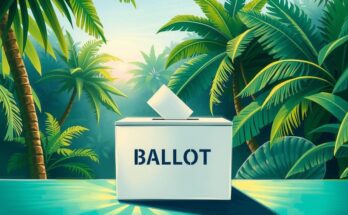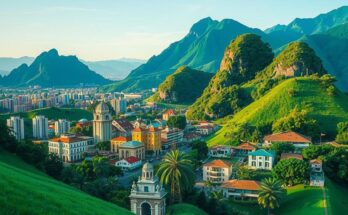The upcoming elections for Greenland’s parliament have gained international attention following President Trump’s expression of interest in the island. The main issues revolve around whether Greenland should integrate more closely with the U.S., remain part of Denmark, or pursue outright independence. Key parties are advocating for independence, but economic ties to Denmark complicate this issue, as many citizens prioritize maintaining their livelihoods. A potential referendum on independence is under discussion, though its feasibility remains uncertain.
Greenland’s elections for its 31-member parliament, the Inatsisartut, usually go unnoticed due to the island’s small population of approximately 60,000. However, heightened interest emerged following President Trump’s remarks in January regarding Greenland’s strategic and resource-rich significance. This sparked concern in Europe, especially among NATO ally Denmark, which retains control over Greenland’s foreign affairs while the island manages most domestic issues. As a result, the elections on March 11 have gathered global attention, centering on key issues such as American integration versus remaining a part of Denmark or pursuing full independence.
Despite the current international attention, the majority of Greenlanders do not desire American annexation, and no political party is advocating for such a move. Prime Minister Mute Egede and Danish Prime Minister Mette Frederiksen have affirmed that Greenland is not for sale and that its future is a decision solely for its people. Moreover, the parliament has enacted a law prohibiting anonymous and foreign donations in electoral campaigns to ensure transparency.
Historically, the U.S. has shown interest in Greenland, dating back to the 19th century. The territory, being geographically closer to North America, benefits from existing U.S. security assurances via a northern airbase. The Arctic is becoming a focal point for superpowers, with China and Russia exploring the lucrative opportunities arising from melting ice, which could lead to future trade agreements between Greenland and the United States, even without formal American ownership.
A notable portion of Greenland’s populace holds conservative views regarding their homeland, preferring preservation over exploitation of its resources. Currently, only two mines operate on the island, and past elections have reflected a strong aversion to oil and gas exploration as well as a ban on uranium mining. This sentiment shapes the political landscape, where three of the five parties are pushing for independence from Denmark, including Egede’s Community of the People party, which garnered significant support in prior elections.
Nonetheless, the push for independence is nuanced by economic realities. While many Greenlanders express a desire for autonomy, they simultaneously strive to maintain their living standards, which are heavily reliant on Denmark. Approximately 50% of Greenland’s exports are sent to Denmark, with 60% of imports originating there, and a significant part of the population is employed in public sector jobs financed by Danish grants. Recently, Denmark committed 2 billion euros to bolster Arctic defenses in response to security concerns.
A commission is currently exploring the potential for independence, which would involve a multifaceted process. This includes negotiating separation terms with Denmark, organizing a favorable independence referendum, and securing parliamentary approval from Denmark. Pro-independence factions are advocating for a referendum within the next legislative term, yet given the precarious circumstances, a 2025 vote appears uncertain.
The forthcoming elections in Greenland are pivotal, centering on the island’s future concerning its relationship with the United States and Denmark. While aspirations for independence are evident, economic dependencies complicate the situation. As political parties position themselves for the elections, the outcome will significantly influence Greenland’s trajectory, balancing ambitions for autonomy with the necessity of maintaining existing living standards. Furthermore, external geopolitical factors are set to shape the discussions around Greenland’s future.
Original Source: www.rferl.org




